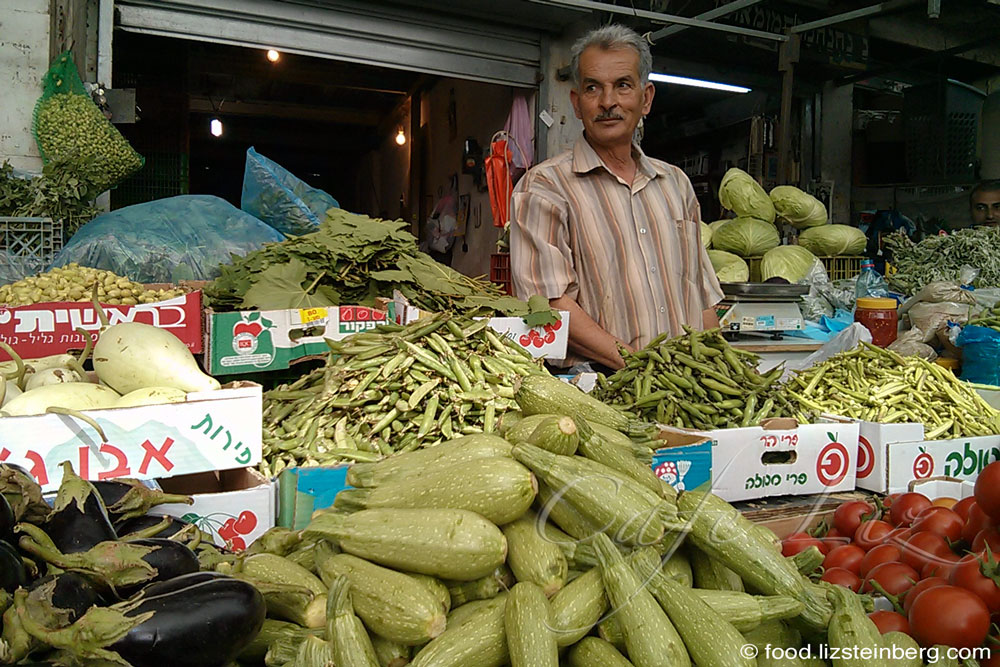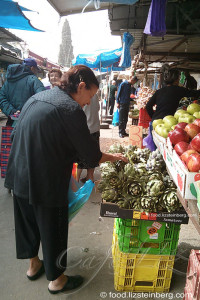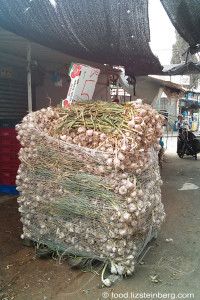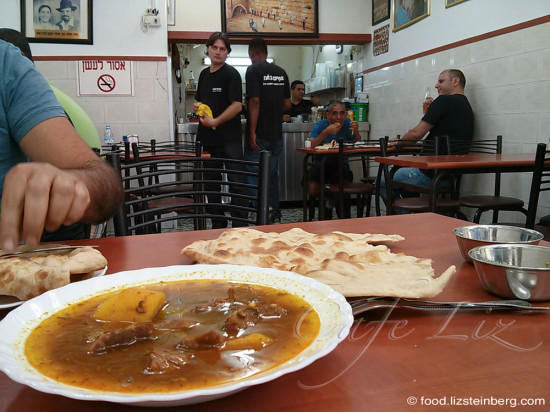Eating lunch at Israel’s markets
To market, to market. It’s been a busy few months, and not because we’ve been up to anything in particular — mostly just due to life. Raising a toddler, working, toddler, work, and then the day is over. It’s not that I haven’t been cooking — cooking has become even more important now that my son is eating regular meals. But somehow it seems that everything gets eaten before I have a chance to photograph it. Or it just bears a striking resemblance to something I’ve already blogged about. Or both.
But we still manage to find time to market hop — least of all because we need to buy food. And I like nothing better than sitting down to lunch at one of the many lovely restaurants that you’ll find alongside markets in this country, restaurants that specialize in one, maybe two kinds of food at most. Lunch can turn a grocery trip into a family outing.
Bourekas and hummus in Ramle
Markets are particularly nice at this time of year, when the weather is pleasant and all sorts of green, seasonal things are coming into season. Here’s one of my favorite stands at the Ramle shook, which I visited with Sarah not long ago (top photo). Ramle is one of the poorer cities in the center of the country, and it is home to a very diverse population — Jews of all colors, including members of the Indian and Ethiopian communities, and also Christian and Muslim Arabs.
What is the seller offering there? All sorts of vegetables beloved by the Arab community in particular — big flat grape leaves waiting to be stuffed; bottleneck squash, also waiting to be stuffed (far left); small eggplants and zucchinis, also waiting to be stuffed (notice a pattern?); hanging bags of fresh green chickpeas; fava beans in their pods; mucousy molokhiya; and tiny little okra, oh-so-time-consuming to trim and prepare. Lo and behold, my 1-year-old loves okra.
We were also there for the garlic — to buy our annual supply, because that’s what you do in garlic season.
And where to eat after all this shopping? There’s Khalil, which offers some of the best hummus and musabaha around, served doused in pepper sauce and good olive oil. There’s also the Turkish bourekas in the middle of the shook, offering spinach or cheese enclosed within crispy, spiraled pastries. They’ll gladly cut the boureka open and add chopped-up hardboiled egg and spicy sauce for you. Add a cup of lemonade, and the whole package will set you back all of NIS 12.50.
Kubbeh in Hatikva
Danny and I have also been visiting the Hatikva shook a little closer to home, in southeast Tel Aviv. Hatikva is one of Tel Aviv’s poorer neighborhoods, home to a veteran community of Jews with origins in countries around the Middle East. Travel southward from north Tel Aviv, and you can see the identity of the pedestrians changing — less trendy, more religious.
You also can tell as you’re approaching the shook in that working-class neighborhood — as our bus headed south, we passed more and more people trudging home their shopping trolleys, crammed with massive bunches of garlic that stuck out haphazardly from the top. The neighborhood also has at least half a dozen toy stores and countless restaurants, most of them Iraqi, Yemenite or meat grills (most all are kosher, but very few are vegetarian-friendly).
At Israel Mercaz Hakubbeh, Danny and I indulged in this massive, steamed kubbeh — savory spiced beef encased a semolina shell, served alongside bright yellow amba sauce — basically, Iraqi mango chutney, made from a liberal amount of turmeric and fenugreek seeds — plus amba-flavored pickles, and the freshest flat pita you could imagine, hot from the cavernous ovens of a bakery down the street (Yehezkel and Sons, Ha’Etzel 76). The kubbeh and condiments will set you back about NIS 17.
Another beloved restaurant down the street is Achim Boaz, a Yemenite restaurant that offers beef and chicken soups, beans, and hummus. Food from a different culture, where the turmeric and the fenugreek take different forms — the fenugreek is served as a different kind of condiment, whipped into a frothy, spicy mix known simply as hilbeh (“fenugreek”), while the turmeric is part of the hawayij spice mix that makes up the base of many a Yemenite soup. Our beef soup had a light, bright-yellow broth, and came served alongside those same fresh pitas, even fresher than at Mercaz Hakubbeh — the bakery is right next door. (NIS 35 for that dish.)
As we were served, the man sharing our table held the pita up to his nose, closed his eyes and inhaled the rich scent of yeast.
Vegetarian-friendly options can be found at Maafiyat Hasalouf, which serves omelets pan-fried into Yemenite bread, a hummus-shakshouka mashup known as the “hamshuka” and malawach, flat pan-fried Yemenite filo pastries.
Vegetarian stuffed vegetables at the Tel Aviv Port
Why is it that traditional dishes, and the traditional restaurants that make them, are often so meat centric? Suffice it to say, part of what I hope to do through my blog is make traditional dishes accessible to vegetarian audiences. But it’s always nice to find others doing this as well, especially when it means you can enjoy vegetarian options while eating out, as opposed to cooking it yourself.
We found one such option at the farmer’s market at the Tel Aviv Port. This market is the diametric opposite to those in Ramle and Hatikva — nestled into one of the most expensive parts of the city (and the country?), offering unusual varieties of produce to an audience that barely flinches at the price. Vegetables and fruits are arranged at stands with a view of the Mediterranean sea lapping at the port’s wooden planks. It’s beautiful and fun, if you can afford it.
But this audience is also much more interested in eating vegetarian, as one of the sellers noted, perhaps with a touch of surprise. Among the various stands offering produce and prepared food you’ll find one little stand selling stuffed vegetables, traditional dishes from a mix of Middle Eastern cultures such as stuffed grape leaves, stuffed onions, stuffed beets and stuffed peppers — traditional except for the omission of meat. You can mix and match; it’s all NIS 65 a kilo. For NIS 45, we had a light meal for three (including a 1-year-old), eaten while sitting to the side of the bustling market.
We finished off with pomegranate juice from the juice stand inside, where dozens of prepared glasses stand waiting like so many brightly colored candies with straws. Pure delight for my son, who likes few things better than drinking colorful things through straws.
In Ramle:
Khalil, Kehilat Detriot 6. Vegetarian and vegan friendly, no kashrut certificate.
Original Turkish Bourekas, Jabotinsky 3 (inside the Ramle market, near the first intersection south of Herzl). Open until the burekas sell out by early or mid-afternoon. Vegetarian and vegan friendly, kosher.
In Hatikva, Tel Aviv:
Israel Merkaz Hakubbeh, Vatik 1, open weekdays for lunch. Not vegetarian friendly, kosher.
Achim Boaz, Haetzel 47. Open for lunch. Not vegetarian friendly, kosher.
Yehezkel bakery, Haetzel 49. Vegetarian and vegan friendly, kosher.
Maafiyat Hasalouf, Hatikva 1. Vegetarian and vegan friendly, kosher. (I’ve written more about them here and here.)
At the Tel Aviv Port farmer’s market:
Vegetarian stuffed vegetable stand, at the northern open-air market on Fridays, outside next to the Arcosteel store. Vegetarian and vegan friendly, no kashrut certificate (to the best of my knowledge, at least).










